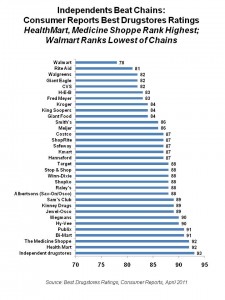 In the pharmacy market battle between Davids and the Goliath, David wins in the latest Consumer Reports survey on best drugstores according to consumers: independent pharmacies come out on top, and Walmart ranks last on the roster.
In the pharmacy market battle between Davids and the Goliath, David wins in the latest Consumer Reports survey on best drugstores according to consumers: independent pharmacies come out on top, and Walmart ranks last on the roster.
The most highly-rated chains, highly indexed at 90 or more points, Health-Mart, The Medicine Shoppe, Bi-Mart, Publix, Hy-Vee, and Wegmans. Target, which was just ranked the #1 retailer in brand equity by the Harris Poll (where Target also beats Walmart in general retailing brand equity), ranked lower with an 88: much higher than Walmart with a 78 index, but below Walmart’s Sam’s Club and several grocery chain-based pharmacies.
Consumer Reports points out that pharmacies consistently satisfy readers better than most other stores or services, and certainly better than supermarkets and cell-phone providers, on par with electronics stores. A score of 80 means that consumers were very satisfied. These results are based on Consumer Reports readership and may not reflect the general populations’ perceptions.
There are some interesting aspects to these survey findings:
- There are more “freebies” for health available at pharmacies in 2010-11, including free diabetes drugs and antibiotics (a 14-day supply of commonly prescribed generic versions), low-priced generic Rx drugs (usually a 30-day supply for $4 or three months’ worth for $10), and discounted immunizations for chicken pox, flu, hepatitis, measles, pneumonia, and tetanus. This is important because pharmacists in every state are now allowed to administer inoculations without a doctor’s involvement.
- ePrescribing is still under-utilized nationally. Surescripts notes that about 40% of doctors are now using eRx, up from a mere 1% last year. However, this is only 18% of all prescription volume.
- After independents, supermarket pharmacies are the second most beloved type of drugstores. There are about 9,000 supermarket-based pharmacies, which are expanding levels of service around the pharmacy. Some have begun to offer online ordering with store pick-up. Safeway will mail Rx’s, and Hy-Vee has registered dietitians on-staff for consumer Q&A.
- The Big Box and mass merchandise stores’ pharmacy attraction is cost, cost and cost. They’re growing in market share of Rx’s: since 2002, big-box prescriptions have grown from 14% to 22% of the market. However, their lower levels of service mean waiting in lines, stores running out of drug supply, and lack of personalized attention.
- CR also surveyed favored pharmacy benefits managers, finding that Tricare — the PBM for the U.S. armed forces — takes the top spot (who says the government can’t run a consumer-friendly program?)
Consumer Reports National Research Center polled 43,739 respondents between April 2009 and April 2010 who had experiences purchasing prescription drugs at walk-in chains, independent, supermarket, and mass-merchandise stores.
Health Populi’s Hot Points: Independent pharmacies remain one of the last mom-and-pop retail artifact left in the U.S. economy. While they’re holding their own in numbers, just, they will continue to face declining reimbursement and economic pressures like other retail segments. Nonetheless, this survey speaks to the beloved role they play in their local communities among people who frequently fill prescriptions. Their level of customer service is well above the national chain drugstores, attested by 50,000 CR subscribers.
Is high-level service at a chain or Big Box pharmacy an oxymoron? Does it have to be? As ePrescribing grows among prescribing physicians, retailers of all flavors should position themselves to be more responsive in real-time to consumers — who can clearly walk with their feet. Most big chain pharmacies now offer a financial inducement — say, a $20 gift card — to move prescriptions from other pharmacies. I have personally taken advantage of this — not for the marginal money but for better service, convenience and parking. I moved from a national chain to a discount chain known for its beautifully-designed prescription drug packaging. Thus, far, the service has been outstanding and the counseling very professional and, at the same time, warm, personal and accessible.
Pharmacies will increasingly become a key node in the accountable care and medical home environment of health care delivery re-design. They have a huge opportunity in helping bolster positive health behaviors, medication adherence and good patient outcomes. Whether the large chains and big-box stores will do as good a job as independents and grocery stores is their opportunity to win or lose in this evolving health ecosystem.




 I am so grateful to Tom Lawry for asking me to pen the foreword for his book, Health Care Nation,
I am so grateful to Tom Lawry for asking me to pen the foreword for his book, Health Care Nation,  I love sharing perspectives on what's shaping the future of health care, and appreciate the opportunity to be collaborating once again with Duke Corporate Education and a global client on 6th May. We'll be addressing some key pillars to consider in scenario planning such as growing consumerism in health care, technology (from AI to telehealth), climate change, and trust -- the key enabler for health engagement or dis-engagement and mis-information. I'm grateful to be affiliated with the corporate education provider
I love sharing perspectives on what's shaping the future of health care, and appreciate the opportunity to be collaborating once again with Duke Corporate Education and a global client on 6th May. We'll be addressing some key pillars to consider in scenario planning such as growing consumerism in health care, technology (from AI to telehealth), climate change, and trust -- the key enabler for health engagement or dis-engagement and mis-information. I'm grateful to be affiliated with the corporate education provider  Thank you FeedSpot for
Thank you FeedSpot for